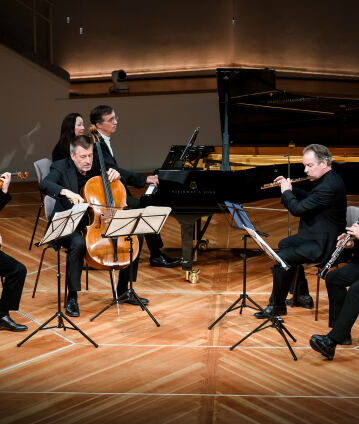Philharmonic chamber music: From the First Viennese School to Modernism

Four soloists from the Berliner Philharmoniker and pianist Éric Le Sage present chamber music from Vienna: in addition to famous works such as Beethoven’s Gassenhauer Trio and Mozart’s Violin Sonata K. 304 in an arrangement for flute and piano, there are also discoveries – such as the highly Romantic Pieces for Cello and Piano by the young Anton Webern. The finale and highlight is Schoenberg’s Chamber Symphony No. 1.
The works in this programme were composed between 1795 and 1913 and revolve around two important stylistic periods that owe their names to Vienna: the First Viennese School represented by Haydn, Mozart and Beethoven, and the Second Viennese School headed by Arnold Schoenberg. Schoenberg and his pupils consciously followed in the tradition of the Classical period, which preceded them by around a hundred years. The similarities lie in the sophisticated thematic work, the balance between melody and harmony, and the great importance of chamber music. As a “conservative revolutionary” (Willi Reich), Schoenberg finally took leave of traditional harmony by composing in free atonality and with twelve equal notes.
The programme, conceived by four of the Berliner Philharmoniker’s section leaders together with the French pianist Éric Le Sage, ranges from Haydn and Beethoven to Schoenberg and his master students. Beethoven strikes a lively Viennese popular tone in the finale of his famous Gassenhauer Trio, and while Anton Webern’s early cello pieces have a late-Romantic sound, Schoenberg, in his Chamber Symphony No. 1, pushed the boundaries of tonality – which Alban Berg had already abandoned in his Opus 5 for clarinet and piano.
© 2024 Berlin Phil Media GmbH